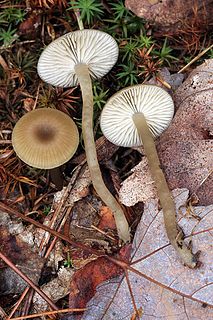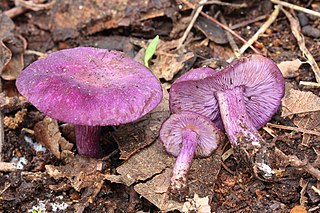
The Tricholomataceae are a large family of mushrooms within the Agaricales. Originally a classic "wastebasket taxon", the family included any white-, yellow-, or pink-spored genera in the Agaricales not already classified as belonging to e.g. the Amanitaceae, Lepiotaceae, Hygrophoraceae, Pluteaceae, or Entolomataceae.

Leucopholiota is a genus of fungi in the mushroom family Tricholomataceae. It consists of the species Leucopholiota decorosa and Leucopholiota lignicola.
Pegleromyces is a genus of fungi in the family Tricholomataceae. It is a monotypic genus, containing the single species Pegleromyces collybioides, found in Brazil and described as new to science by mycologist Rolf Singer in 1981.

Amparoina is a genus of fungi in the family Tricholomataceae. The genus contains two species found in South America.
Austroclitocybe is a genus of fungi in the family Tricholomataceae. The genus is monotypic, containing the single species Austroclitocybe veronicae, found in temperate South America. The genus was circumscribed by Jörg H. Raithelhuber in 1972.

Caulorhiza is a genus of fungi in the family Tricholomataceae. The genus, which contains three species found in the US, was circumscribed by Joanne Lennox in 1979.

Cellypha is a genus of fungi in the family Tricholomataceae. The widespread genus contains 10 species.
Cyphellocalathus is a genus of fungi in the family Tricholomataceae. This is a monotypic genus, containing the single species Cyphellocalathus cecropiae, found in Bolivia.

Fayodia is a genus of fungi in the family Tricholomataceae. It was first described by Robert Kühner in 1930, and the specific epithet honors the Swiss mycologist Victor Fayod. The widespread genus contains 10 species, mostly in the northern temperate regions.

Gamundia is a genus of fungi in the family Tricholomataceae. The genus contains six species found in Europe and temperate regions of South America.

Leucocortinarius is a genus of fungus in the family Tricholomataceae. It is a monotypic genus, containing the single species Leucocortinarius bulbiger, found in Europe.
Lulesia is a genus of fungi in the family Tricholomataceae. The genus contains three species found in tropical regions.

Myxomphalia is a genus of fungi in the family Tricholomataceae. The genus has a widespread distribution in north temperate areas, and contains four species.
Neoclitocybe is a genus of fungi in the family Tricholomataceae. The widespread genus contains 10 species that are especially prevalent in tropical regions.

Phyllotopsis is a genus of fungi in the family Tricholomataceae. The widespread genus contain five species that are predominantly in temperate regions.
Physocystidium is a genus of fungi in the family Tricholomataceae. This is a monotypic genus, containing the single species Physocystidium cinnamomeum. This species is found in Trinidad, and was originally described as new to science in 1951 as Collybia cinnamomea by mycologist R.W.G. Dennis; Rolf Singer transferred it to the then newly created genus Physocystidium in 1962.
Pleurocollybia is a genus of fungi in the family Tricholomataceae. The genus contains five species found in the Americas and Asia.

Tricholosporum is a genus of fungi in the family Tricholomataceae. It was circumscribed by Mexican mycologist Gastón Guzmán in 1975.
Tricholosporum longicystidiosum is a species of fungus in the family Tricholomataceae. Found in Mexico, it was described as new to science in 1990.











